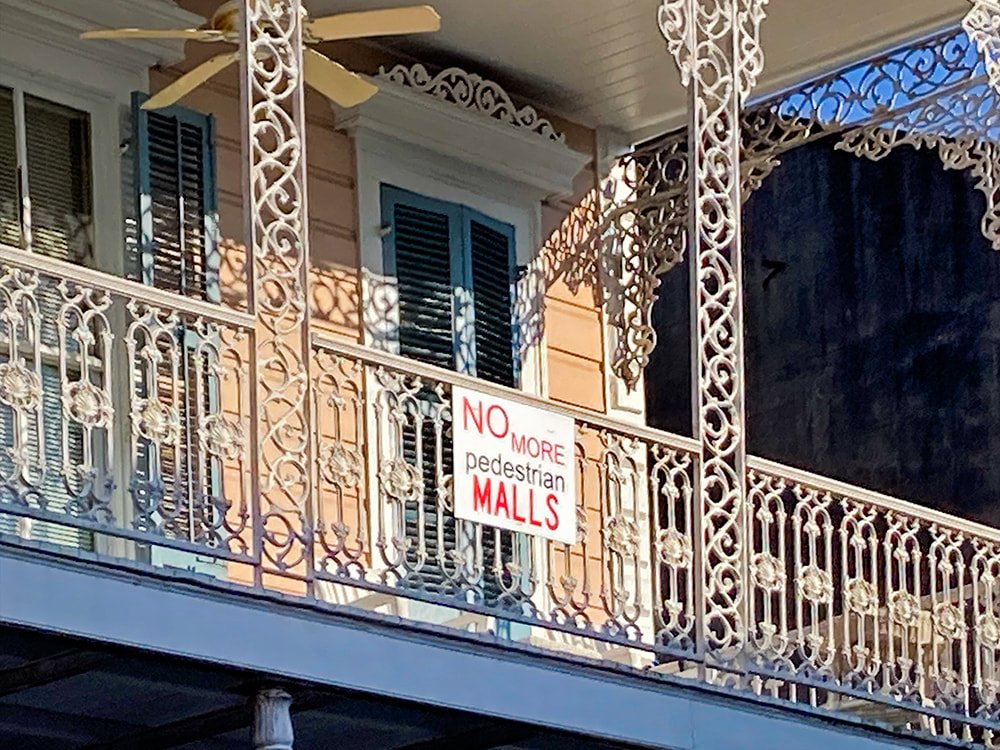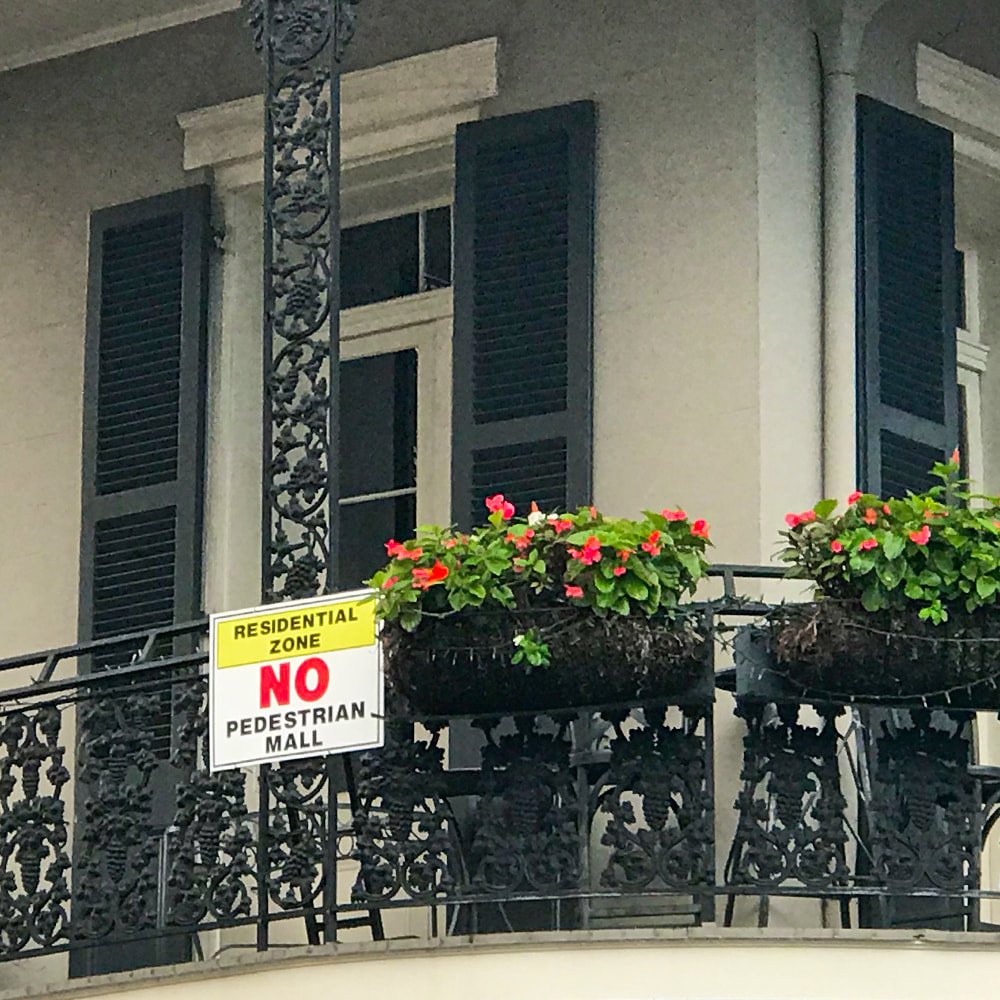Reimagining: Considering the Quarter's New Normal
1934 photograph of Jackson Square before it was pedestrianized. Photograph by Richard Koch, Library of Congress
The COVID shutdown has intensified efforts to balance French Quarter business and residential concerns in the city's oldest neighborhood.
- by Frank Perez
In May, two months after the pandemic caused the city to shut down, Mayor Cantrell announced a sweeping proposal to “Reimagine the French Quarter” and make it more pedestrian-centric.
.
The initial draft of the proposal consisted of seven key concepts:
Reduce speed limits
Make North Rampart safer
Create a “civic spine” with an expanded pedestrian mall along Orleans Avenue
Prohibit vehicular traffic on French Market Place
Turn Frenchmen Street into a pedestrian mall nightly
Transform 16 Blocks in the Upper Quarter into a pedestrian mall nightly
Expand the sidewalk along N. Peters/Decatur Streets
A screenshot from the initial proposal showing possible gateway treatments to slow traffic. Click for the initial proposal itself (it's currently being amended, keep reading for more info).
Public reaction has been mixed. Concepts (3) and (6) have been particularly controversial and already generated public protests. The City insists nothing has been set in stone and welcomes feedback.
To that end, the Mayor's office reported on nola.gov that Councilwoman Kristin Gisleson Palmer, whose District C includes the French Quarter neighborhood, “launched an External Pedestrianization Team made up of French Quarter leaders to run in parallel with the City’s Pedestrianization Team, discuss pedestrianization approaches, and provide feedback and guidance on initial concepts.”
Screen shot from the initial proposal showing possible concepts for the French Market area. Click to view full initial proposal (which is currently being modified).
The French Quarter Business Association (FQBA) website quotes Councilwoman Palmer: “A reduction of the car and truck traffic could improve the quality of life for residents while making a more sustainable setting for visitors. ... Such a project needed the input of key stakeholders early on, which is why I convened a working group of French Quarter residents and business owners who have been providing feedback to the administration’s team on a weekly basis.”
Although no official action has been taken and the public outreach phase had just begun, opposition to pedestrianization was swift and fierce.
Opposition group French Quarter Citizens held a protest rally on August 15 outside 819 Orleans Avenue. The rally featured statements by FQC President Glade Bilby, and signs opposing pedestrianization were distributed to the crowd.
Another citizens group, Vieux Carré Property Owners, Residents & Associates (VCPORA), has also come out against the proposal, stating on its website:
“VCPORA will not endorse any effort that contributes to the commercialization of the neighborhood by prioritizing visitors over residents. We will not support any concept that prohibits or limits a resident’s access to their own home. We can, however, support concepts that will help maintain the diversity and authenticity of this remarkable neighborhood by providing tools for local businesses. We support efforts to reduce the impact of vehicles in the French Quarter and the associated issues of congestion, damage to historic buildings, pedestrian safety, and air quality. We support improvements to our aging infrastructure so that Vieux Carré remains an enjoyable place to live, work, and visit.”
VCPORA has provided a careful analysis of the issue at vcpora.org.
Micah Loewenthal, who lives on Orleans Avenue with his partner Jonathan Dolese, told French Quarter Journal that “Orleans Avenue from North Rampart to Bourbon Street is solid residential. It's just not suited for a pedestrian mall. We purchased our home with the intention of having off-street parking. The City’s spine plan would have blocked our access to our own driveway, inconveniencing us and devaluing our property. Most residents in the area have similar concerns.”
Also opposing the pedestrian mall concept is Kevin Molony, longtime Quarter resident and head of the Sustainable Tourism Task Force (STTF). Molony and the group weighed in on Facebook in mid-July: “The current draft of ‘Reimagining the French Quarter’ proposals is obviously the product of a considerable amount of thought. ... [But is] breathtakingly blind to the essential nature of historic city centers and their value to the local community and to visitors.”
STTF has for the last few years assembled and studied data on the effects of excess tourism not only in New Orleans, but also in other cities such as Venice, Lisbon, Amsterdam, and Spain’s Balearic Islands. The group also pointed out growing global concerns about “party tourism”:
“Other major historic tourist destinations have come to the understanding that party tourism is toxic and that the first priority must be a historic center that is a healthy, vibrant, living neighborhood for locals—which is precisely what attracts the culture-seeking visitors everyone wants. Yet the mayor's ‘Reimagining the French Quarter’ team is proposing ... even more commercialization in our city's historic center, dramatically expanding on the existing party-town model of the Bourbon Street Entertainment Zone. ... If implemented, these pedestrian malls would decimate the residential fabric of the historic neighborhood — tearing apart what other cities are wisely working to mend.”
Screenshot from the presentation of the Sustainable Tourism Task Force. Much of the presentation shows how New Orleans is one of many popular destinations world-wide suffering from over tourism. The presentation observes that "the historic center of New Orleans receives more than five times the visitors per resident as Venice."
Not everyone agrees that pedestrianization is a bad thing. Tom Reagan, who has owned a home on Gov. Nichols since 1976, points to hundreds of European cities that have successfully limited vehicular traffic in their historic centers. Reagan lived for a time in Lausanne, Switzerland and cites Lausanne and Geneva, Switzerland as examples of how pedestrianization can work well for locals as well as visitors.
Brittany Mulla McGovern, executive director of the French Quarter Business Association, which has been involved in drafting the proposal’s key concepts, emphasizes that nothing is set in stone and that the City is in the very early stages of a long process. She also says the FQBA has concerns about the civic spine and other aspects of the overall proposal.
Councilperson Palmer hosted the first in a series of public meetings via Zoom on August 17. In the meeting, which was attended by nearly 300 people, Palmer stressed that the proposal is still in its early stages, and there will be more meetings to gather community feedback.
The overwhelming majority of responses and comments during the meeting expressed opposition to more pedestrian malls. Many people suggested city funds would be better spent fixing potholes and cracked sidewalks.
Palmer issued another statement on September 11 saying she had requested removal of the Orleans Civic Spine project from consideration of the French Quarter Reimagine proposal.
“There are many aspects of the administration's initial proposal I welcome, including reducing the speed limit of interior streets to 15 mph, traffic calming measures on North Rampart to improve the connection between the Quarter and Armstrong Park, and the proposed one-block street closure around French Market. I also believe that particular attention should be paid to activating the different alleyways in the Quarter as proof for how some of these concepts could be implemented and managed.
However, after studying the plans and hearing from residents and businesses owners, I think there are outstanding concerns around the maintenance of existing infrastructure and regulation of existing pedestrian malls that will need to be addressed for the community to feel confident that further efforts will work and be a benefit to the neighborhood and businesses.
I am encouraged by the fact that the administration has dedicated $2 million in sidewalk repairs and hope that additional funding can be secured at the state level for similar projects. I look forward to the co-design process and will continue to advocate for a plan that improves residents' quality of lives while ensuring businesses can prosper."
Orleans Avenue, view from Burgundy Street, looking toward the river. photo by Ellis Anderson
Opposition to expanded pedestrian malls is rooted in a highly contentious dichotomy — prioritizing of French Quarter residents vs. catering to tourists. This debate is nothing new. The number of permanent French Quarter residents has been rapidly declining for decades while the tourist industry has continued to grow. Consider these population statistics for the French Quarter:
1940—11,053
1950—9,530
1960—7,669
1970—5,257
As the number of residents decreased, the number of hotels rooms increased. In 1959, there were 740 hotel rooms in the French Quarter. Ten years later, there were 2,655. According to the 2010 census, there are 3,888 people living in the French Quarter, a number which most agree is significantly lower now. More recently, the proliferation of illegal short-term rentals has driven out even more locals.
There is a general consensus among opponents of expanded pedestrian malls that the Quarter needs more permanent, full-time residents, and that more pedestrian malls is not the way to achieve that end. European models notwithstanding, local history suggests they may be right.
In 1973, St. Peter, Chartres, and St. Ann streets were closed to vehicular traffic along Jackson Square and benches were added on those streets to accommodate increased foot traffic. At the time, this idea generated fierce opposition from residents in the Pontalba apartment buildings and preservationists such as Martha Robinson. They argued the street closures and massive influx of tourists would drive out the residents of the Pontalba buildings and leave behind only a thin veneer of what was once an authentic slice of residential life in the Quarter.
The St. Peter street side of Jackson Square before pedestrianization. Photo by Richard Koch, 1936, LOC
They were correct. 47 years later, despite a handful of year-round residents, the Pontalba apartments are mostly rented by out-of-towners and corporations. Even during events like French Quarter Festival, most of the balconies are devoid of life.
Currently (as of October 4 2020), city is refining the concepts based on feedback and will host individual meetings (or “charettes”) for each of the concepts for increased focus. The first charette (date TBA) will address the French Market Place concept.
In regards to additional outdoor dining, last Thursday (Oct. 1) the city announced:
It is partnering with the New Orleans Business Alliance to continue accepting applications for $2,000 grants. The grant program assists restaurants — and now bars — in refitting for outdoor service. Applications began being accepted on October 2.
The city is also launching a pilot program for restaurants in the Downtown Development District (DDD) to create “parklets” — outdoor dining spaces created in areas usually used for on street parking. Only restaurants within the DDD boundaries (in the French Quarter, that's Iberville to Canal) are eligible for the pilot (October 5 - 19) now, but restaurant and bar owners outside the DDD boundaries who are interested in participating in the next round can submit their information now for permits.
Starting in mid-October, the city and the French Market Corporation will be launching a “Safe and Social” demonstration. French Market Place between Gov. Nichols and Ursulines will be closed to traffic from 8am Thursday morning until 8am Monday. This proposal was one that received much positive public feedback, with the goal “to create new opportunities for French Market vendors, connections for local businesses and ways for patrons to interact with one another in safe, socially distanced encounters.”
Navigating the tension between crass commercialism and historic preservation, between tourist and residential interests, has always been a delicate balance that has increasingly tipped in favor of business and tourism. Opponents of expanded pedestrian malls fear they will be the final blow in destroying the residential fabric of the Quarter.
Such fears may be warranted, but are they really justified? That question is at the heart of the “Reimagine the French Quarter” controversy. The devil, as they say, is in the details, and those details are still being worked out.










